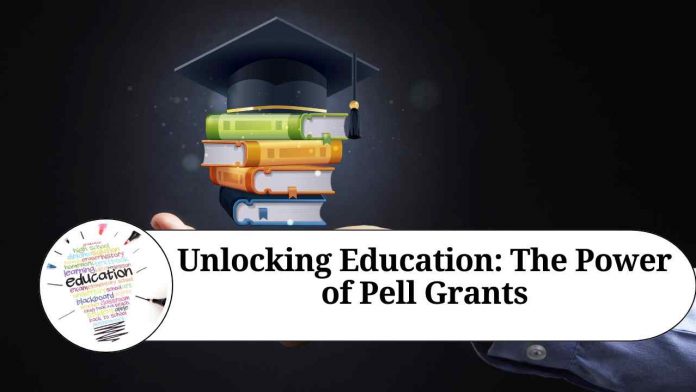Introduction
In today’s rapidly evolving world, education has become an essential key to success. However, for many individuals, the dream of pursuing higher education remains out of reach due to financial barriers. Fortunately, Pell Grants have emerged as a powerful tool to unlock educational opportunities for students from low-income backgrounds. In this blog post, we will explore the significance of Pell Grants and the transformative impact they have on students and society as a whole.
Understanding Pell Grants:
Pell Grants, named after the late U.S. Senator Claiborne Pell, are federal grants awarded to undergraduate students who demonstrate exceptional financial need. These grants do not require repayment, making them a valuable source of funding for those aspiring to earn a degree. The Federal Pell Grant Program is the largest need-based grant program in the United States, providing financial assistance to millions of students each year.
Enabling Access to Higher Education:
One of the primary goals of the Pell Grant Program is to expand access to higher education for students from economically disadvantaged backgrounds. By providing financial aid, Pell Grants break down the barriers that often hinder students from pursuing a college education. This grant serves as a lifeline, enabling talented individuals to enroll in accredited colleges, universities, and vocational schools, regardless of their financial circumstances.
Empowering Students:
Pell Grants empower students to achieve their academic goals and unlock their full potential. With the burden of financial constraints lifted, students can focus more on their studies, engage in extracurricular activities, and participate in internships or research opportunities. This holistic educational experience fosters personal growth, enhances critical thinking skills, and prepares individuals for successful careers.
Reducing Educational Inequality:
Education has the power to bridge the gap between social and economic disparities. Pell Grants play a pivotal role in reducing educational inequality by ensuring that financial limitations do not dictate a student’s educational trajectory. By providing opportunities to students who would otherwise struggle to afford higher education, Pell Grants contribute to a more equitable society where talent and potential are not limited by socioeconomic factors.
Boosting Economic Mobility:
Access to education is a catalyst for economic mobility, allowing individuals to break free from the cycle of poverty. Pell Grants serve as an essential tool in this process, empowering students to obtain valuable degrees and credentials. By increasing educational attainment among low-income individuals, Pell Grants pave the way for better job prospects, higher earnings, and improved socioeconomic status. This not only benefits individuals but also strengthens the overall economy by creating a skilled workforce.
Investing in the Future:
Pell Grants are not only an investment in the individual but also in the future of our society. By making education more accessible, we nurture a diverse and talented pool of individuals who will become the leaders, innovators, and professionals of tomorrow. These individuals bring fresh perspectives, unique ideas, and contribute to the advancement of various fields. The ripple effect of Pell Grants extends beyond the recipients, shaping a more inclusive and prosperous society for generations to come.
Conclusion
Pell Grants have emerged as a transformative force in the realm of education, breaking down financial barriers and unlocking opportunities for countless individuals. By expanding access to higher education, empowering students, and reducing educational inequality, Pell Grants play a vital role in fostering economic mobility and building a brighter future. As we continue to prioritize the importance of education, let us recognize and support the enduring impact of Pell Grants in shaping a society that thrives on equal opportunities for all.
Other Related Blogs: Section 144B Income Tax Act
Frequently Asked Questions (FAQs)
Q: What are Pell Grants?
A: Pell Grants are federal grants provided by the U.S. Department of Education to eligible undergraduate students who demonstrate significant financial need. These grants do not require repayment and are designed to assist students in covering the costs of their education.
Q: How do I qualify for a Pell Grant?
A: To qualify for a Pell Grant, you must be an undergraduate student pursuing your first bachelor’s degree or a qualifying post-baccalaureate certificate. You must also demonstrate financial need, as determined by completing the Free Application for Federal Student Aid (FAFSA). Factors such as your family’s income, assets, and household size will be considered in determining your eligibility.
Q: How much money can I receive from a Pell Grant?
A: The amount of money you can receive from a Pell Grant is determined by your financial need, cost of attendance at your chosen institution, and your enrollment status (full-time or part-time). The maximum award amount for the 2022-2023 academic year is $6,495. However, the actual grant amount can vary depending on your individual circumstances.
Q: Can I receive a Pell Grant if I attend part-time?
A: Yes, you can receive a Pell Grant if you attend college part-time. However, the amount of the grant will be prorated based on your enrollment status. For example, if you are enrolled half-time, you may receive half of the maximum award amount.
Q: Can Pell Grants be used for any type of college or university?
A: Pell Grants can be used at most accredited colleges, universities, and vocational schools that participate in the federal student aid programs. This includes community colleges, four-year institutions, and some trade schools. However, it’s important to check with the specific institution to ensure they accept Pell Grants.
Q: Can I use Pell Grant funds for expenses other than tuition?
A: Yes, Pell Grant funds can be used to cover a variety of educational expenses, including tuition, fees, books, supplies, and living expenses. The funds are typically disbursed directly to the school, and any remaining amount after tuition and fees are paid can be used for other educational costs.
Q: Are Pell Grants available for graduate students?
A: No, Pell Grants are only available for undergraduate students pursuing their first bachelor’s degree or certain post-baccalaureate certificate programs. Graduate students are not eligible for Pell Grants but may qualify for other types of financial aid, such as federal loans or assistantships.
Q: How do I apply for a Pell Grant?
A: To apply for a Pell Grant, you need to complete the Free Application for Federal Student Aid (FAFSA). The FAFSA collects information about your financial situation and helps determine your eligibility for various types of federal student aid, including Pell Grants. The application is available online at fafsa.gov, and it’s recommended to submit it as soon as possible after October 1st of each year.
Q: Are Pell Grants renewable?
A: Pell Grants are generally awarded on an annual basis, and you must reapply each year by submitting the FAFSA. Renewal eligibility is based on financial need and other eligibility criteria. It’s important to note that the renewal of Pell Grants is subject to funding availability and any changes in your financial circumstances.




















